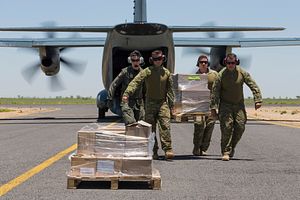Ahead of Australia’s May elections, Prime Minister Scott Morrison last week launched the Liberal Party’s national security policy plan, A Safer Australia. A Secure Future. While the plan lists big-ticket funding commitments across a range of traditionally security focused areas, it is noteworthy in its distinct broadening of the church of national security, and includes details on economic planning, domestic violence, and vaccination schedules. The inclusion of these nontraditional issues may well be welcome to some; however, without a clear notion of how these issues fit within the wider frame of national security – or without even a clear conception of what Australia’s national security outcomes are – the plan poses more questions than it answers.
Does the inclusion of social protections and outcomes change, challenge, or enhance the more traditional state-centric outlook? Are perpetrators of domestic abuse and anti-vaccination campaigners an existential threat to the nation, or is the scope of security changing? Does the plan signal a shift in how these issues will be prevented and prosecuted in the future? As the plan lacks any definition of security, and does not detail any specific goals or outcomes for the nation as a whole, the plan fails to provide any sense of clarity about what sort of “security” the Liberal Party aims to uphold.
The lack of any overarching statement or direction is unfortunate given the clarity afforded to individual issues in the plan. The Liberal Party’s defense ambitions, including in acquisition and defense spending are notable. Fifty-four new naval vessels, the arrival of the F-35, and upgrading the M1 Abrams all receive a mention, as well as a clear statement of intent to lift defense spending to 2 percent of GDP by 2020-21, which the Party claims will be the biggest rebuild of the Australian Defense Force since World War II.
Furthermore, the plan is clear in its details of increased counterterrorism spending, “to protect Australians from terrorism, especially the threat of violent, extremist Islam.” This includes additional funding to the Australian Federal Police, resulting in almost 300 more intelligence and forensic experts, tactical response and covert surveillance operators. The plan also affirms the controversial policy of cancelling the citizenship of Australian dual nationals engaging in terrorist conduct. Airport security, cargo, and mail facilities are also set to receive a boost.
The plan also notes that “Australia’s national security is intertwined with our Indo-Pacific Neighbors,” and as such details several initiatives in the Pacific, including infrastructure financing, military cooperation, policing support, and new diplomatic missions in five Pacific nations. However, while the plan provides specific details for Pacific engagement, it is unfortunately silent on the wider Indo-Pacific region; Southeast Asia and the Indian Ocean are given no air time.
The issues of domestic violence and child protection are also clearly articulated, with attention paid to funding for frontline services, local infrastructure such as CCTV and public lighting, and priority housing services for victims of domestic abuse. Given that two people a month are killed in domestic violence cases (versus the roughly one per year to terrorism over the same period) as well as its extensive effects on the wider community, the inclusion of domestic violence as a security issue is more than reasonable. However, the plan gives no indication of whether this inclusion signals a shift in the way that the ruling party conceptualizes domestic violence as an issue, whether it signals a shift in how national security is conceptualized, or how the inclusion of these domestic concerns could be reconciled with existing national security expectations. Likewise, the plan is clear in regards to how it will protect children and youth — eSafety, immunization, and mental health are all focal issues – but it is completely silent about how these issues integrate into the national security space.
This clarity in specificity is welcome, but given that vaccinations and domestic violence prevention are put in the same document as geopolitical and strategic concerns, analysts are likely left wondering what security means to the Liberal Party; where it starts and ends, what it entails, and what outcomes will be realized through its maintenance. It is clear that the Liberals are ready to support the inclusion of human security issues in their national security aims; however, do these inclusions change, challenge or enhance the existing state-centric outlook?
The desires of the state and the desires of the citizenry do not always coalesce, and it is in the best interests of all concerned that expectations are clearly outlined. While many would agree that the Liberal Party should be commended for the gravity they have now given to these social outcomes, by failing to deliver any clear intent or direction regarding how these concerns interact with the wider security environment, the plan risks confusing far more than it informs.
Samuel Bashfield is a postgraduate student at the Australian National University, undertaking a Master’s of National Security Policy
James Mortensen is a doctoral candidate of Australian National University’s National Security College.

































